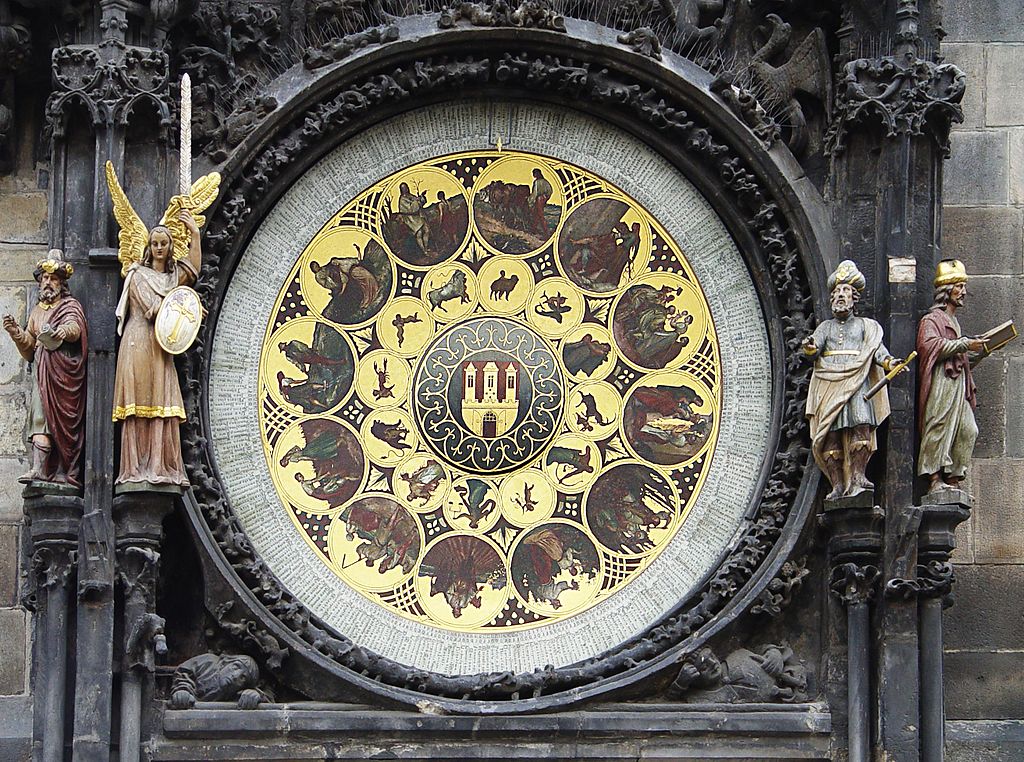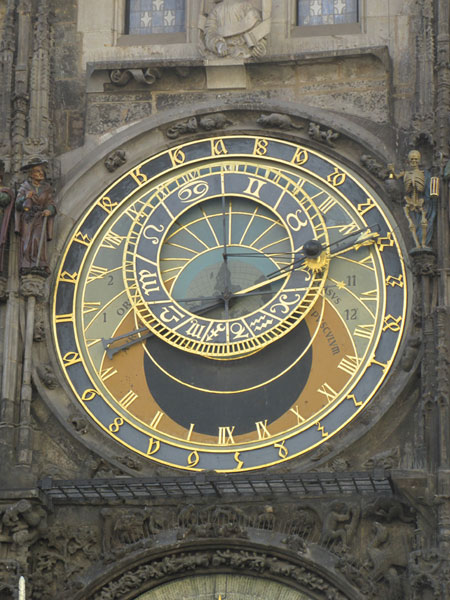The Prague astronomical clock, or Prague orloj , is a medieval astronomical clock located in Prague, the capital of the Czech Republic.
The Orloj is mounted on the southern wall of Old Town Hall in the Old Town Square. The clock mechanism itself has three main components: the astronomical dial, representing the position of the Sun and Moon in the sky and displaying various astronomical details; "The Walk of the Apostles", a clockwork hourly show of figures of the Apostles and other moving sculptures—notably a figure of Death (represented by a skeleton) striking the time; and a calendar dial with medallions representing the months. According to local legend, the city will suffer if the clock is neglected and its good operation is placed in jeopardy; a ghost, mounted on the clock, was supposed to nod its head in confirmation. According to the legend, the only hope was represented by a boy born on New Year's night.
History.The clock tower
The oldest part of the Orloj, the mechanical clock and astronomical dial, dates back to 1410 when it was made by clockmaker Mikuláš of Kadaň and Jan Šindel, then later a professor of mathematics and astronomy at Charles University. The first recorded mention of the clock was on 9 October 1410. Later, presumably around 1490, the calendar dial was added and the clock facade was decorated with gothic sculptures.
Formerly, it was believed that the Orloj was constructed in 1490 by clockmaster Jan Růže (also called Hanuš); this is now known to be a historical mistake. A legend, recounted by Alois Jirásek, has it that the clockmaker Hanuš was blinded on the order of the Prague Councillors so that he could not repeat his work; in turn, he disabled the clock, and no one was able to repair it for the next hundred years.
In 1552 it was repaired by Jan Taborský (ca1500–1572), master clockmaker of Klokotská Hora, who also wrote a report of the clock where he mentioned Hanuš as the maker of this clock. This mistake, corrected by Zdeněk Horský, was due to an incorrect interpretation of records from the period. The mistaken assumption that Hanuš was the maker is probably connected with his reconstruction of the Old Town Hall in the years 1470–1473. The clock stopped working many times in the centuries after 1552, and was repaired many times.
In 1629 or 1659 wooden statues were added, and figures of the Apostles were added after a major repair in 1787–1791. During the next major repair in the years 1865–1866 the golden figure of a crowing rooster was added.
The Orloj suffered heavy damage on May 7 and especially May 8, 1945, during the Prague Uprising, when the Germans fired on the south-west side of the Old Town Square from several armoured vehicles in an unsuccessful attempt to destroy one of the centers of the uprising. The hall and nearby buildings burned along with the wooden sculptures on the clock and the calendar dial face made by Josef Mánes.[4] After significant effort, the machinery was repaired, the wooden Apostles restored by Vojtěch Sucharda, and the Orloj started working again in 1948.
The Orloj was renovated in autumn 2005, when the statues and the lower calendar ring were restored. The wooden statues were covered with a net to keep pigeons away.
Now, in July 2017, the Orloj is again being renovated.













